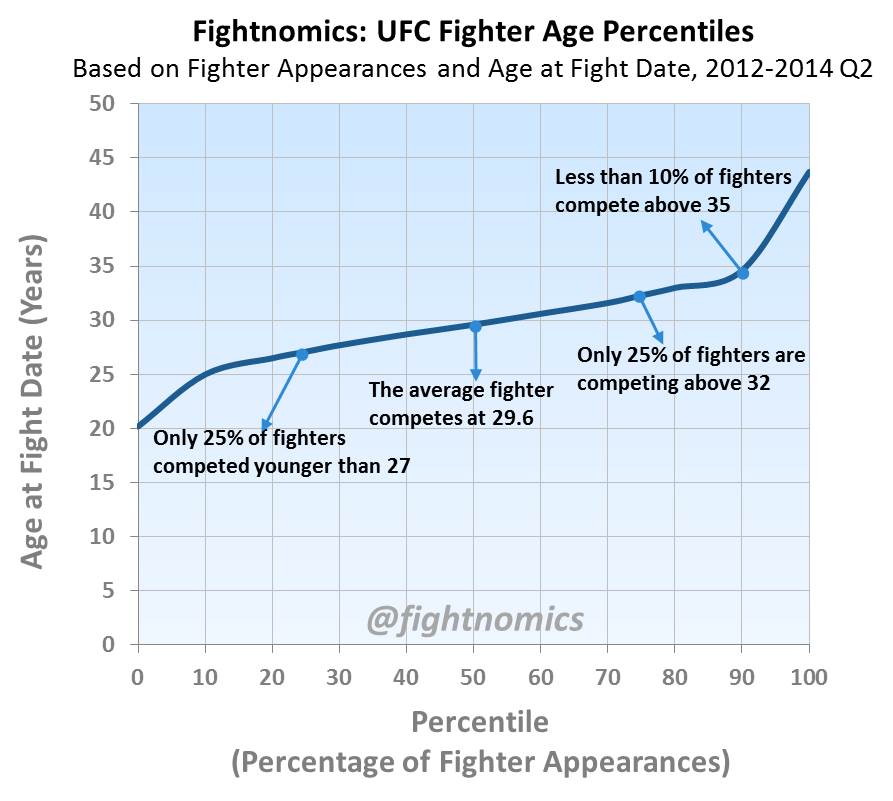By @fightnomics When I first started analyzing historical MMA data, a surprising variable immediately popped out. Fighter age was a critical factor in assessing matchups, leading to what I dubbed the “Youth Advantage” in MMA whereby younger fighters tend to outperform older ones, all other things being equal. The biggest difference in older fighters is not declining skill, but rather diminished resiliency. Once a fighter passes 31, it’s downhill from there. And beyond age 35, their risk of knockdowns is much higher than when they were younger. So when you look at the Tale of the Tape before a matchup, how do you know if a fighter is “old” by MMA standards? Here’s a quick breakdown.
Age is an important metric in highly competitive sport like MMA. For more on the nuances of how the “Youth Advantage” works, as well as other Tale of the Tape factors, get the book “Fightnomics” at Amazon.
Despite the fact that it’s easy to name a bunch of fighters beyond the age of 35, they actually represent only a tenth of fighter appearances making up the UFC fight cards in recent history. That’s partly due to the “Availability Bias” that more famous fighters are easier to remember. Famous fighters tend to be successful ones, and therefore are further along in their careers. These older fighters also tend to fight less frequently than their younger peers, which does have to do with the physical resiliency and recovery ability that declines with aging. Here’s a short list of guys at least 35 years old still active in the UFC:
- Vitor Belfort
- Michael Bisping
- Josh Koscheck
- Hector Lombard
- Lyoto Machida
- Gray Maynard
- Frank Mir
- Mark Munoz
- Constantinos Philippou
- The Nogueira brothers
- Anderson Silva
- Wanderlei Silva
- Dennis Siver
Many of these fighters suffered recent knockout losses, and several more have had to come off TRT. As the average age in the UFC declines with time, the recent TRT ban may cause the most rapid drop in average age this year, due to many older fighters being quickly ushered towards retirement. Once fighters hit the age of 35, they’re into do-or-die mode for title contention, and although some may challenge for the title at this age, very few will take the belt from a much younger champ. Predicting the long-term success of fighters presumes that they still have some room on the runway of their careers. Will Michael Bisping ever compete for a UFC title? Probably not, because time is not on his side. With a recently announced fight with Luke Rockhold, Bisping is going to enter his next fight with a clean sweep of anthropometric disadvantages (reach, age, and stance) that all favor Rockhold. When the deck is stacked against an athlete, it makes a competitive environment that much more unforgiving. Legends that have built up a lot of recognition in their careers often get used as stepping stones for younger up-and-comers, sometimes leaving fans to witness their heroes thrown to the young lions. While this makes sense from a business standpoint to promote future talent, putting these guys into a “Seniors” bracket and pairing them only with older opponents can also still put butts in seats, and is far more sporting for the athletes involved. Maybe they’re not on the fast track to a title, but two former champions facing off for the right to retire on a win is still a compelling draw. The data also gives us a good cutoff of about 30 years old as the median for UFC fighters. If fighters are similarly aged, there’s not much to factor in regarding an age differential. But if one fighter is significantly below 30, and their opponent is clearly above it, there’s the effect of the Youth Advantage that will start to kick in. Any fighter above the age of 30 is in the upper half of the UFC, and while not necessarily “old” by many standards, they are starting to test their career endurance. Basic factors like age play a big role in sports, because Father Time is a relentless asshole. As a man above the “old” threshold for MMA myself, I am thankful I didn’t try a career in fighting as I am still in my “prime” by normal standards. Accepting the end of a career can be a frightening and intimidating door to open, and one that sometimes comes too reluctantly (and too late) for fighters who are pushing their limits. “Fightnomics” the book is now available on Amazon! Follow along on Twitter for the latest UFC stats and MMA analysis, or on Facebook if you prefer.
